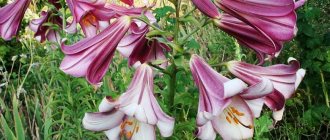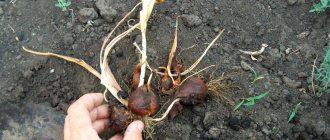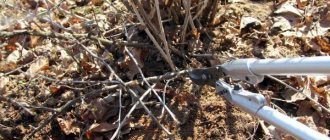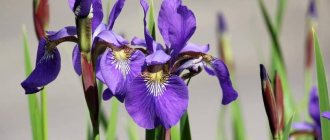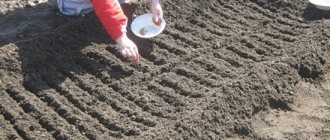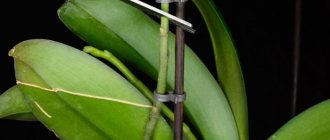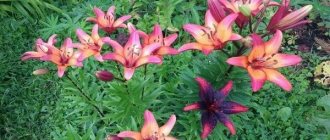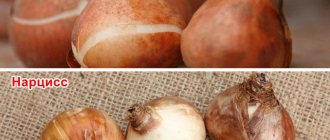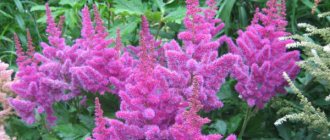Skip to content StandardMebel
Website about furniture, fittings and design
Home » Useful
Healthy
Author Igor Reading time: 18 min. Published 07/28/2020
Do I need to prune faded irises, how and when to prune irises after flowering. When to trim the leaves of irises and care for irises afterwards.
Irises are delicate, beautiful flowers that can rightfully be called the decoration of any garden. Among the people you can find another name for them - iris. The plant blooms at the end of May. Flowering continues until mid-summer, however, if you maintain the irises with constant care, you can extend it a little. Irises are perennial plants, so you need to think through such stages of care as replanting, pruning, digging and storage in advance.
Basic procedures for caring for irises are:
- Loosening the soil.
- Removing weeds.
- Feeding flowers.
- Prevention and treatment of diseases.
- Watering irises.
- Transplanting and pruning irises.
We can easily figure out basic care methods, but questions arise with things like, for example, pruning irises after flowering. Is it necessary to do this? How to prune irises after flowering? Let us answer without boring you: you need to prune irises after flowering as soon as the plant fades.
Peduncles are removed at the base, but not without damaging the root collar. It is important to carry out the procedure before the first frost appears, otherwise the irises may not be saved. In addition, you need to make the dormant period a little easier for flowers by removing half the leaves of irises at the end of flowering.
This is a similar procedure to the one that was performed when landing, so you are definitely familiar with it. Half the leaves are not cut off only if they have already bloomed or become noticeably yellow - then there is simply no point in such a procedure.
How to care for pruned irises after flowering?
After the end of flowering and subsequent pruning, the irises need to be fed and replanted. It is also possible to completely remove irises from the soil mixture, after which they are sent for storage.
Feeding irises is carried out a month after the end of flowering! Only mineral fertilizers are used, and then it is necessary to focus on the potassium and phosphorus components. One spoon (15 grams of fertilizer) per flower of each component will be enough. Organic fertilizers during this period, especially fresh manure, are strictly prohibited, as they cause rotting on the roots and subsequent damage by infections and pests. Sometimes compost is allowed as a light top dressing as needed.
The best varieties of white and cauliflower for Siberia (photo). Characteristics of each variety, features of growing cabbage in Siberia
For replanting, a new suitable place is chosen, then the irises are removed from the soil mixture and transferred to new holes, buried in soil. The distance between each iris flower is 40 centimeters. You can shorten individual roots (in adult plants) to 8 centimeters. They can also be treated with a weak (pinkish) solution of potassium permanganate to prevent the occurrence of infectious diseases or rot.
It is also recommended to plant irises 10-15 centimeters higher than in the previous zone. Again, fertilizing after transplantation is based only on mineral fertilizers, excluding organic components. The first watering after all the procedures is carried out on day 5 - the irises need to adapt to the new planting site, germinate without experiencing stress.
Any novice gardener wants to properly care for a perennial plant, especially a flowering one. How to prune irises? When to do this? Should I leave a fan of leaves?
Iris is often called iris. Iris flowers have been grown for a very long time and now there are more than 1000 varieties of plants with different bizarre shapes and colors of buds.
This is a perennial plant and requires some care in order to delight every year with beautiful flowers and large blooms. One of the important elements of flower care is how to prune it correctly. Over many, many years, gardeners have learned how to better care for flowers.
How to prune irises correctly? When should this be done? Is it necessary to leave a fan of leaves?
Irises are pruned several times a season depending on the indicators:
- Fan of leaves – yellow, spotted;
- End of flowering period;
- Autumn period and frosts;
- Iris variety.
Let's look at the most important periods when it is necessary to prune irises. Tips and care rules in this article will help you properly care for the plant.
Removing individual flowers, stems and foliage
Irises should be pruned throughout the spring and summer. To remove plant parts, use special scissors, pruning shears, or even your fingers.
Foliage trimming
- Trimming single flowers. Each iris bush produces several luxurious flowers in turn. And those that bloomed earlier will, accordingly, be the first to wither. In this case, dry or wilted flowers must be removed from the stem. Not only do they look unattractive and spoil the overall appearance of the flower garden, but they also draw beneficial substances from the stems onto themselves, thus taking away the strength of flowers that are at the peak of flowering or are just opening.
- The irises have bloomed - remove the entire stem. After the irises have completely flowered, it is necessary to remove the flower stalks so that they do not take nutrients from the leaves and do not provoke rotting of the entire bush. The cut should be made at the very base of the bush. It is appropriate to compost the trimmed parts.
- Caring for and cutting iris leaves. In early spring, when the earth has warmed up at least a little, the first shoots of irises begin to emerge. By mid-May, they have already grown to standard sizes and the flowering process begins. After flowering, the flowers are removed, but not the leaves. Firstly, they contribute to the landscaping of the flower bed. Secondly, they become conductors of solar energy to the roots. Since the plant is perennial, the rhizomes overwinter in the ground at very low temperatures. To survive the frost, a flower needs to stock up on strength.
It is imperative to monitor the appearance of dry and rotten leaves and remove them. Only at the end of the season can you cut off all the foliage.
When to prune peonies for the winter
vseprodachu.ru
Flower growers do not argue about whether it is necessary to prune peonies for the winter. Young and old plants of this crop need annual autumn pruning, which will prepare them for the upcoming frosts and allow them to gain strength after exhausting flowering. The procedure must be carried out strictly before frost, so that flower buds have time to form for next year. If you prune too early, the peony will not bloom next year. Late pruning is problematic because peonies soften after exposure to cold and will be difficult to cut.
Wait until the peony leaves begin to wilt naturally, and then trim all shoots to 4-5 cm from the soil level. Make sure that the buds are preserved on the stems. Sprinkle the cuttings with ash (1-1.5 cups per bush). Water the bush generously before wintering.
Peonies survive winter frosts quite well. It is enough to insulate them with humus or rotted manure. The mulch layer should be at least 10 cm, in cold regions - 15 cm. Cover young plants planted this year with an additional layer of spruce branches.
Do not compost plant residues after pruning, but burn them. Larvae and pupae of pests and pathogenic bacteria may remain in them.
Peonies in October - secrets of planting, care and propagation Didn't have time to divide and replant peonies in August-September? Don't worry, there is still time for the most important work.
Advice from experienced flower growers
At the time when you plan to prune faded irises, you should prepare your tools. In order not to damage a still strong plant, it is worth using small garden shears with a powerful and sharp blade. The first time it is necessary to cut off the withered bud and a small part of the peduncle - up to 5 cm. The rest is best removed when it withers at a height of 2 cm from the soil.
As for the leaves, they should only be cut off in the fall before being sent for the winter. In the summer, even if the plants have flowered for a long time, they cannot be cut, because useful substances accumulate in them. Removal of foliage should be done a couple of weeks before the onset of cold weather.
Since there are quite a few varieties, everyone can choose those that will decorate the site. If you take proper care of the plants, they will delight gardeners with their appearance for many years, decorating the plots.
These are the nuances that gardeners should know about when to prune irises and peonies after flowering. Taking them into account, it will be easy to create comfort in your own area.
Diseases and pests
Despite the fact that irises are considered resistant to diseases and insect pests, sometimes plants require help and treatment.
Rotting of roots and bases of leaves
The reason for the development of this problem is excessive soil moisture. To eliminate the problem, the plant is dug out of the ground and all damaged areas are cut off. The remaining healthy root system is treated for half an hour with a solution that stimulates plant growth. Then the iris is slightly dried in the sun for at least twelve hours.
Heterosporosis
Small brown spots form on the leaves of the plant. As a therapy, all affected leaves are cut off and burned. The plant is treated with copper sulfate. To prepare a solution, dilute 50 g of the drug in five liters of water.
Gladiolus thrips
This is the most dangerous pest for irises. As a result of its presence, iris leaves lose their waxy shine and look lethargic. You can get rid of the insect using special preparations.
Feeding irises after flowering
Irises respond well to fertilizers. After their introduction, they bloom more beautifully and more luxuriantly. The risk of disease is reduced
It is important to correctly select organic and inorganic substances. For example, these plants react positively to potassium fertilizers, as well as phosphorus fertilizers.
It is important to feed the flower beds on time. It is worth making 3 feedings per year: 2 in spring and 1 in autumn.
Important! All fertilizers are applied before frost begins.
Autumn fertilizers
They are applied three weeks after flowering. In this case, the flower is already in a state of hibernation. Then young roots grow, so fertilizing during this period is necessary.
Fertilizing irises
At the beginning of September, the flower beds are fertilized with a potassium-phosphorus mixture. Be sure to maintain a 3:2 ratio. Other supplements are also needed: potassium salt, superphosphate, organic additives. For 1 m² you need to take 55 g of superphosphate and 25 g of salt
It is important not to forget about the proportions and respect them
Note! Feeding irises with fresh manure is strictly prohibited, as this will provoke the appearance of fungus, other dangerous bacteria and diseases, as a result of which the flower will definitely not receive the necessary substances. In extreme cases, humus will do
It will have a positive impact on the culture. It must first be diluted with water. Proportion: 1 kg of manure per 10 liters of water.
The above fertilizers will not save you from pests. In this situation, it is enough to simply spray the flower beds with Bordeaux mixture. This way they will be reliably protected until spring arrives.
Important! Careful use of fertilizers will help avoid unfortunate consequences, including damage by viruses, insects and bacteria
Spring fertilizers
Active growth occurs in spring. To speed it up and maintain it, it is worth introducing fertilizers.
The very first feeding occurs immediately after winter after the snow melts. It is necessary to include the same potassium-phosphorus, as well as nitrogen fertilizers. Nitrogen supplements are especially needed in the early period. However, it is recommended to introduce them no later than July. Their need is for the plant to grow stronger, gain strength, and slowly prepare for reproduction. But here the proportions change slightly and are 2:3:2.5. The main thing is not to overfeed the flowerbeds, otherwise a period of mineral deposition will begin - fattening. This is fraught with consequences for flowers.
For your information! Phosphorus fertilizers take place if the soil has warmed up well enough. Otherwise, this will lead to the deposition of substances, and subsequently to poisoning of the soil and grass.
For special protection against insects and other dangerous pests, gardeners recommend covering the soil with wood ash. Consumption is 2 tbsp. spoons on a flower.
Iris rhizomes
How to prepare irises for winter (video)
You should not rush to remove the shelter with the arrival of the first thaw. If frost returns, the plant may be damaged. If you want to supply oxygen, the shelter can be carefully turned.
Irises look beautiful both alone and together with other flowers. Not all varieties bloom the first year after planting, so you should be patient and continue to care for the plants. At 3–4 years old, the iris will definitely delight you with its bright colors.
Irises are considered one of the most unpretentious flowering crops. To achieve abundant and long flowering, you need to properly prepare the plants for wintering. Today we will tell you how irises are prepared for winter in different climatic zones.
Irises, which people affectionately call iris or cockerels, attract attention with a variety of shapes and colors. There are more than 700 varieties of this ornamental crop in nature.
Irises quickly and easily adapt to different climate zones if they are given proper care.
Autumn care for flowering crops includes moisture-recharging watering. Moistening the soil is necessary if the weather is dry and hot. If there is a lot of precipitation in the fall, it is recommended not to moisten the soil. Excess moisture in the soil can lead to rotting of the rhizomes of garden crops.
Shrub pruning plays an important role in caring for irises. Pruning means removing a wilted or dried bud from a flowering plant. Failure to comply with the technology and timing of this procedure can lead to weakening of the flower, including a decrease in its winter hardiness.
Pruning of irises is carried out after the peak of flowering. This procedure consists of several stages:
At the end of flowering, you need to pinch off with your fingers or cut off the upper part of the flower, which is located immediately behind the bud, with garden pruners.
Please note that not only the fading/drying part of the peduncle should be removed, but also the green receptacle. Improper pruning will result in a new ovule appearing in place of the green receptacle. Check the degree of bud opening daily
Flowers that have not yet fully opened or are in the active flowering stage are not removed. After flowering, it is necessary to cut off all flower stems. The stem is cut off almost at the very base - at a distance of 2-2.5 cm from the rhizome. Do not remove flower stalks and stems from plants that bloom several times during the season. For example, the bearded iris produces buds twice. Iris uses its leaves to nourish its root system, so don't rush to trim them. Dried and withered tips of leaves are cut off in mid-autumn.
Pruning and preparing irises for winter depends on the varietal characteristics of the plant and the climate of the growing region.
Aftercare
10-14 days after pruning the flower stalks, garden plants are fertilized. According to experienced gardeners, iris does not tolerate fertilizing the soil with organic matter. Therefore, it is better to use superphosphates and any potassium salts to feed this ornamental crop. If winter is expected to be early, long and very severe, it is better to feed garden ornamental crops before pruning. Plants need time to heal wounds and recover.
Cover rules
Frost-resistant plants should not be covered all over for the winter. But all planted or transplanted flowers must be covered. In addition, even if the above-ground part is open, the root system needs shelter. In autumn, around the irises, you need to cover a layer of mulch 20-25 cm thick. Suitable for this: dry soil, low-lying peat, humus.
Covering the aerial parts of less resistant varieties should be done with spruce branches or other similar material. Do not use straw, hay, or leaves. This type of shelter melts when there is a thaw. As a result, mold and diseases appear on the ground.
There is no need to rush to cover the irises. If the weather is changeable, then due to the large layer of covering material, damping off of the roots may occur. As a result, the plant dies. In spring, there is no need to remove the cover from the plants very early, as frosts will damage them. But you can raise the spruce branches a little.
Thus, caring for irises in the fall and preparing for winter are important procedures, without which the normal development of flowers is impossible. They ensure beautiful flowering of these wonderful plants.
The success of wintering irises largely depends on the specific variety planted on the site. In the southern regions of Russia, you can grow various types of irises, while in the middle zone - only frost-resistant varieties that have already been tested in this region (the seeds must be obtained from plants previously grown in our climate zone).
According to many gardeners, low-growing irises tolerate winter much better. Of the bulbous irises, iridodictiums and English medium-sized irises of the Giant variety winter well. Of the rhizomes, it is better to give preference to dwarf bearded irises. The popular low-growing Spanish and Dutch irises endure our winters much worse. Of the tall rhizomatous irises, it is better to plant wild beardless varieties (bristly, marsh, yellow, oriental and Siberian) on the site. Colorful and very decorative Japanese varieties, as well as all types of tall bearded irises, are more heat-loving and do not winter well in our latitudes.
To a large extent, wintering depends on the choice of planting site and proper care of plants during the growing season. This directly determines how well the irises can prepare for the coming winter.
Bulbous irises are best planted on small elevations with well-permeable soils (not clayey). This location will further prevent stagnation of water near the bulbs.
Rhizomatous irises should be planted so that part of their roots is necessarily above the soil surface. It is she who is more susceptible to freezing during cold winters. However, with proper preliminary care, even frozen roots will remain alive.
From mid-July, it is necessary to completely stop feeding irises with nitrogen fertilizers. Instead, in subsequent months, complex fertilizers are applied once a month, diluting one tablespoon of this fertilizer in 10 liters of water. From the end of August, watering is significantly limited and the amount of weeding that disturbs the plants is reduced. If replanting is necessary, it is done before mid-September, so that after this the plant has enough time to adapt and prepare for winter.
Around the first days of November, the foliage of irises is cut into a cone at a level of 15 cm from the ground. This pruning significantly improves water flow. Trimmed leaves are not used as mulch; peat should be used for these purposes (spreading the rhizomes with a 10 cm layer). The top of the shelter is covered with spruce branches.
Regardless of the frost resistance of the variety and type of irises, be sure to cover the plants in the first year after planting and very old bushes whose rhizomes are largely on the surface. The experience of recent years shows that one cannot always count on a snowy winter (natural shelter).
Remove the cover in the spring when the snow melts. The soil from the rhizomes should be raked a little so that their “backs” begin to warm up faster. Immediately you can easily detect areas of roots that have frozen over the winter - they will become like mush. Such places must be removed with a spoon down to healthy hard tissue, otherwise they can serve as a source of disease. After this procedure, the wound must be treated with a solution of potassium permanganate or brilliant green, and after drying, sprinkled with wood ash.
Many gardeners love garden iris, which is easy to care for and can easily withstand wintering. Only hybrid varieties can bring difficulties. Today we will talk about the features of caring for these flowers in the fall.
Weeding and thinning
Weeds, as you know, create shadows; the soil in their thickets is not ventilated, the sun’s rays do not penetrate there, and high humidity is created. In such conditions, fungal diseases, in particular rot, develop well. Juicy orris root is highly susceptible to them. Therefore, be sure to remove weeds.
After weeding, examine the bush itself. Irises have a strongly growing root; in one season it can produce 4 or more children. Young rosettes crowd each other and compete for food. As a result, there is little energy left for flowering: the more neglected the bush, the fewer buds it has.
If the bushes of your irises are too dense, arm yourself with pruning shears or a knife and cut them close to the ground or break out weak shoots, leaving only large ones without yellow spots on the leaves. If after this the bush remains dense, then thin out the strong shoots so that they stand and do not touch each other.
Video: thinning irises after flowering
Caring for bulbous irises after flowering is completely different, about the same as caring for tulips. Only to dig up the bulbs do not wait for the leaves to completely turn yellow, but start at the moment when the tips of the leaves just begin to dry out. In this phase, irises are dug up, their bulbs are dried and stored in a warm room. They are planted again in the flowerbed at the end of August.
Types of fertilizers for irises
Feeding of irises in the fall is necessary for root species that overwinter in open ground. Both organic matter and mineral fertilizers can be used as nutrients.
How to fertilize irises in the fall:
wood ash is an organic substance that supports the root system thanks to potassium and phosphorus, contains a full range of microelements necessary for the plant’s immunity, and serves as food for soil microorganisms that improve soil characteristics;
compost – contains most nutrients and humus, due to its loose consistency it improves the air permeability of the soil;
humus that has lain for at least 2 years;
mineral fertilizers – complex or single-component, containing potassium and phosphorus.
Fresh manure should not be used to feed irises in August, as it contains a lot of free ammonia. Because of it, plants can begin to grow before frost and die from the cold. Even compost is recommended to be used for 2-3 years.
The best option for feeding irises in August is an ash solution. To do this, pour 200 g of the substance into a bucket of water and leave for 3–4 days.
Then it is poured into the recess around the root collar and covered with a layer of earth.
In the spring, you will only need to fertilize with nitrogen fertilizer or complex fertilizer - such as nitrophoska or azofoska. Various means are used that accelerate rooting and contain amino acids and substances that cause the growth of root tissue. You can buy them at a gardening store.
Humus is added in liquid form by dissolving 2 shovels in a bucket of water.
There is no need to insist on it. It is desirable that all the fertilizer gets into the soil and does not remain on the surface. After humus, the plants are not fertilized for 2–3 years.
With the exception of sandy soils, which require restoration every year. Sand holds nitrogen fertilizers especially poorly. They quickly go into the lower layers of the soil, and the iris root cannot reach nitrogen.
Compost, which is used to fertilize irises after pruning, is simply dug up with the top layer of soil
This is done carefully so as not to damage the fleshy roots with the shovel. If this happens, the damaged area is treated with potassium permanganate or dry ash.
There is organic matter that takes a long time to decompose in the soil. This is bone meal, which is used to feed irises in the fall. Partial dissolution of animal residues takes time, so this fertilizer is not used in the spring. Pour boiling water over the bone meal and wait until it cools.
The resulting solution is poured into the soil. Soil bacteria immediately get to work and process organic matter, but they do this gradually, so that by spring the bettas will be provided with the phosphorus and calcium necessary for growth and metabolism.
When to prune irises for the winter
There are no exact dates, but you can focus on the climatic features of your region. In the southern regions, this can be postponed until the end of November, and in central Russia, irises can be pruned before the first frost, which most often occurs at the beginning of November. Northern regions may require this to be done a month earlier.
If you do not tie the pruning of irises to any time limits, then it is quite advisable to time this work to rainy weather, when the plant needs increased ventilation to prevent waterlogging of the root system.
You need to monitor the appearance of irises immediately after their flowering, 2 weeks after its completion, and cut off all the faded arrows, leaving no more than 2 centimeters from the base, so that the bush does not rot.
Care
Gardeners should know more than just whether they need to prune irises for the winter. It is important to take proper care. After flowering has finished, water the plants frequently; a couple of waterings are required in the fall. And if the weather is rainy, then additional watering is not needed. Irises do not tolerate organic fertilizers well, so you should not use manure or chicken droppings for this.
But mineral fertilizers are excellent. But you need to take into account that nitrogen must be added to the flowers before flowering begins. And in the fall, 2 weeks before pruning or 2 weeks after this, perennials should be fertilized with complex mineral fertilizers consisting of potassium salts and superphosphate. But if fertilizing must be applied after pruning, then there should be at least 2 weeks left before the onset of frost.
When is the best time to prune?
The pruning procedure is best done in the autumn, after the plant has completely faded and the flowers and leaves have dried. The timing largely depends on the region in which the flowers are grown. In most cases, the time coincides with mid-October.
Removal of leaves in the fall is carried out following a number of rules:
- It is better to cut the leaves in the form of a cone;
- the height of the fan of leaves after cutting should be 15 cm from the surface of the ground;
- leaves that are cut should be burned;
- the roots are sprinkled with a layer of dry soil;
- For the winter, the plant is completely covered.
The green part of the plant does not need to be removed. Green leaves continue to nourish the root system of the flower, increasing resistance to frost and other adverse factors.
During flowering
When a flower enters the active flowering phase, it is not recommended to perform any actions with it. It is better to prune only 3.5 weeks after the irises have bloomed. During this time, the plant will restore the strength that went into the formation of flower stalks. In addition, new root branches will begin to appear. The time coincides with the last days of August or the first days of September.
If there is a need to trim flowers during flowering, the procedure is carried out in compliance with some recommendations:
remove only those buds that have already bloomed; it is important not to damage all unopened buds; After the buds wither, the stem is cut off, leaving a height of 3 cm from the root.
After flowering
At the beginning of September, the flowering of irises completely ends. At this time, you should trim the faded flowers along with the stem and cut off the seed pods. The stems need to be cut low - about 2.5 cm above the rhizome. If they are not cut off, they begin to rot.
After trimming the flowers and stems, the leaves can be left until they turn completely yellow. In most cases, removal begins only after they have completely fallen to the ground - in mid-October. Leave a fan of cut leaves 14 cm high.
When transplanting
If you plan to transplant or propagate a flower in the summer, then it is better to cut off the foliage. Leave a fan of cut leaves 17 cm high. The procedure will preserve a sufficient amount of moisture and nutrients in the roots. As a result, the plant will take root faster in a new piece of land.
It is recommended to trim the leaves four days before transplanting. It is better to carry out the procedure itself 14 days after the end of flowering. All activities are carried out in the evening, after sunset.
When the seeds ripen
During the period of ripening of the seed capsule (ripening begins after the flower withers), iris bushes also need pruning. Cut off all dried buds. If it is necessary to propagate a flower, then leave one.
Rules of procedure
The processing result is shown in the photo. How to prune irises for the winter? Dry flowers and ripening seed pods should be removed first. It is then important to remove the stems and flower stalks after the plants have finished flowering. The foliage must be removed after it becomes withered and completely lies on the ground.
For pruning, you need sharp garden scissors or pruning shears - a blunt garden tool damages the stems, which will lead to the process of rotting of the remains of the above-ground parts of the flowers. Dried flowers and ovules should be trimmed or plucked off by hand. Peduncles must be cut at the root.
Dried stems and flower stalks should be trimmed with garden shears, leaving stems about 3 cm high. Withered foliage should be cut at a height of 13-15 cm, only it is important that the plant takes on a cone-shaped shape. Leaves should be cut off in the first ten days of October.
Features of autumn care for irises
Caring for irises in autumn consists of the following activities:
- pruning;
- feeding;
- preventative treatment;
- shelter for the winter.
In autumn, irises need to be well prepared for wintering.
Pruning irises before wintering
Faded flower stalks of irises are removed almost immediately after flowering ends. It is not recommended to cut the foliage until it withers on its own. In the green above-ground part, photosynthesis processes continue, promoting the accumulation of nutrients in the rhizomes, so it cannot be removed.
Peduncles should be cut out immediately after flowering to prevent the formation of a seed pod.
Yellowed leaves are cut off in September or October, depending on the local climate. The fan of leaf plates is shortened to a height of 12–15 cm from ground level, trying to give it the shape of a house roof so that moisture flows down better and does not linger on the cuts.
The leaves of irises are cut off after they wither and turn a little yellow.
Iris leaves are cut at an angle
Video: trimming irises correctly
Autumn feeding of irises
Like most garden crops, irises are fed with fertilizers of the phosphorus-potassium group in the autumn. It is better to do this after pruning, about 2-3 weeks before the first firm frost.
Wood ash is scattered on the bed between the plants
Irises respond well to application (per 1 m2):
- Phosphorus fertilizers: superphosphate - 45–60 g;
- phosphate rock - 150–200 g (no more than once every 4–5 years).
- potassium salt - 25–30 g;
- potassium monophosphate - 45–50 g;
Dry fertilizers are evenly distributed over the previously well-moistened soil under the iris bushes, and then the soil is slightly loosened and granules are embedded into it to a depth of 2–3 cm.
Granules of mineral fertilizers are scattered under the irises and embedded in the soil to a depth of 2–3 cm
Photo gallery: feeding for irises in autumn
Preventive treatment of irises against diseases and pests
Fungal spores persist for a long time on withered and decaying foliage, and pests that have settled in for the winter can also be found on them. For the purpose of prevention, irises are sprayed:
- Fungicides: Tsineb - 45–50 g per bucket;
- Fundazol - 30–35 g per bucket;
- Bordeaux mixture (1%), etc.
- Malathion (Karbofos) - 60 g per 8 l;
Preventative treatments with chemicals are carried out after autumn pruning of irises.
For the purpose of prevention, irises are sprayed against pests and diseases.
Autumn pruning
Do irises need to be pruned for winter in the fall? This procedure is mandatory. With it, it will be possible to prevent the appearance of seeds in the plant; their maturation inhibits the flowering of perennials, since some of the nutritional components are taken away.
In addition, ripe seeds self-sow throughout the garden, causing irises to grow in unexpected places. In autumn it is necessary to remove dry leaves; this preventive measure will protect the plant from insects that will winter in it.
Pruning of irises must be done in the fall so that the plant does not have dried out above-ground parts. This procedure will eliminate dried flowers with peduncles, withered foliage, where pests may be located. In this case, it will be easier to cover the irises for the winter.

